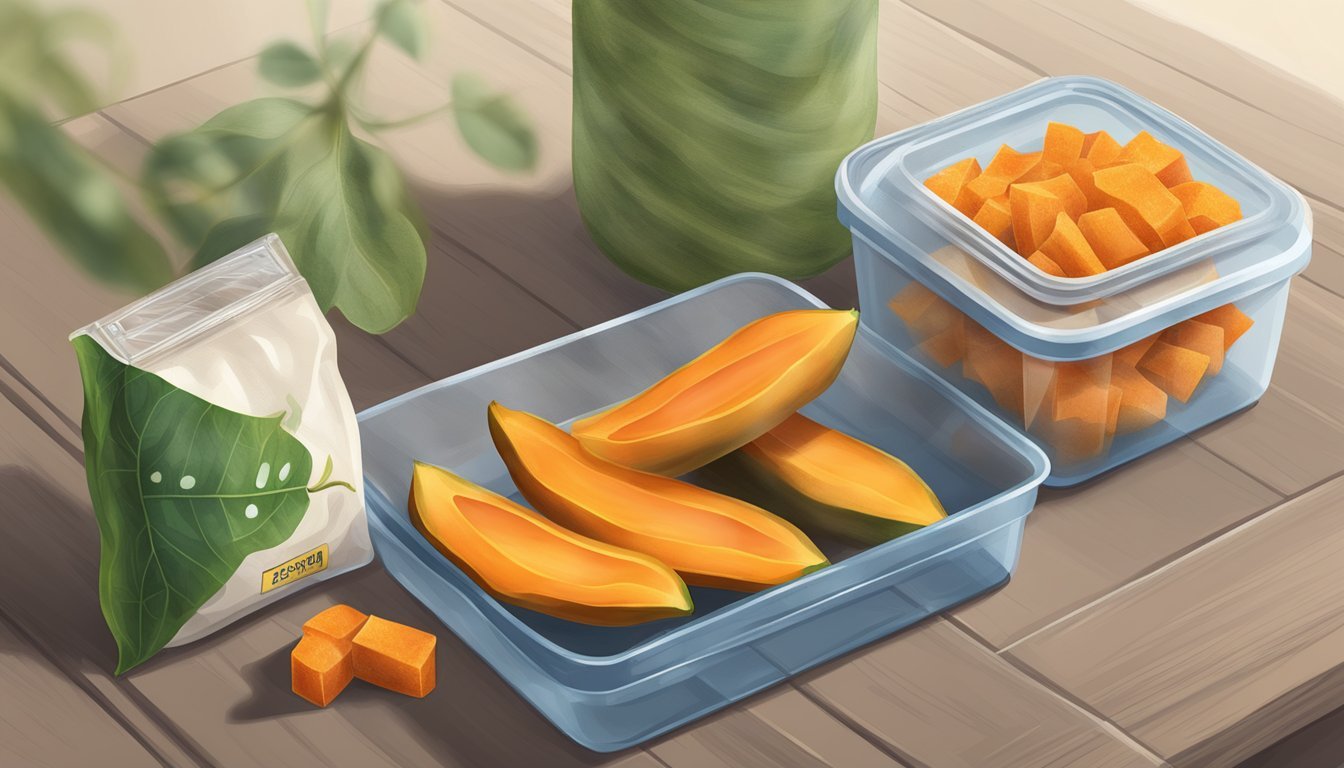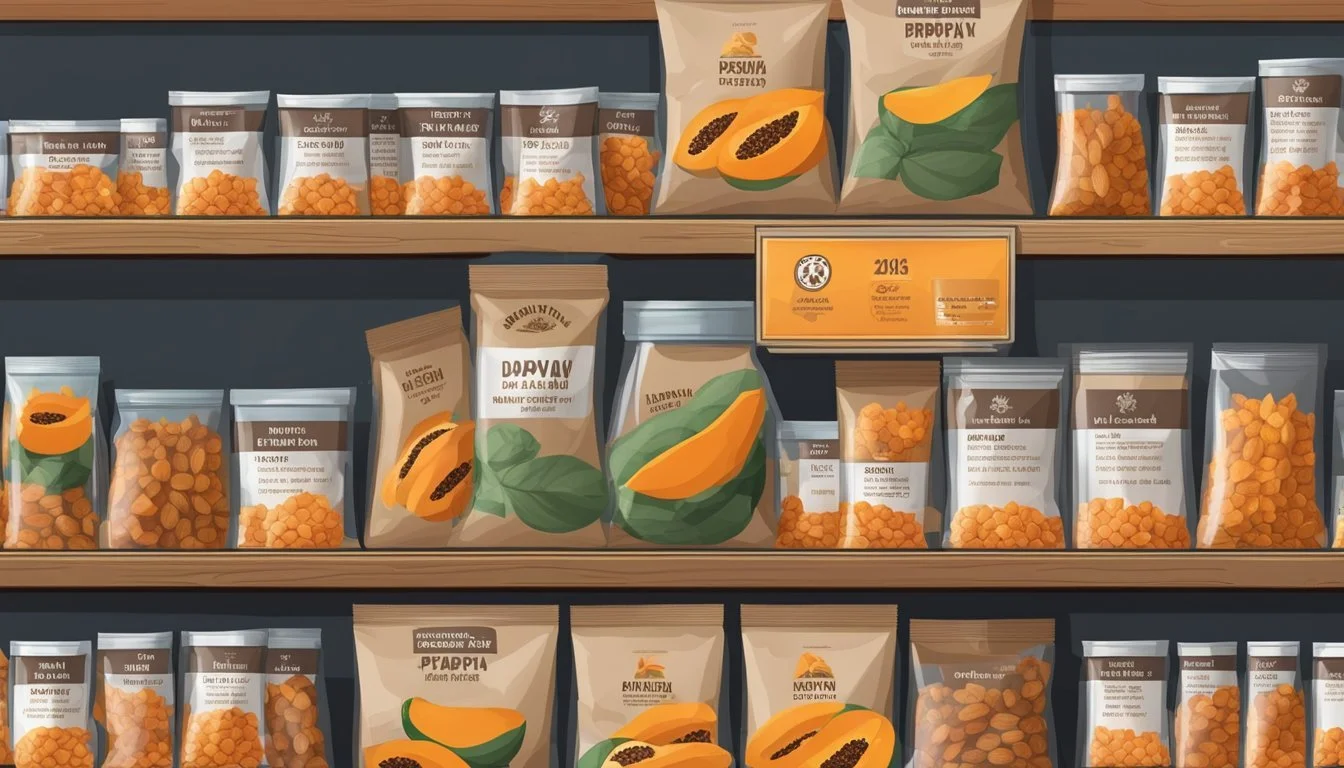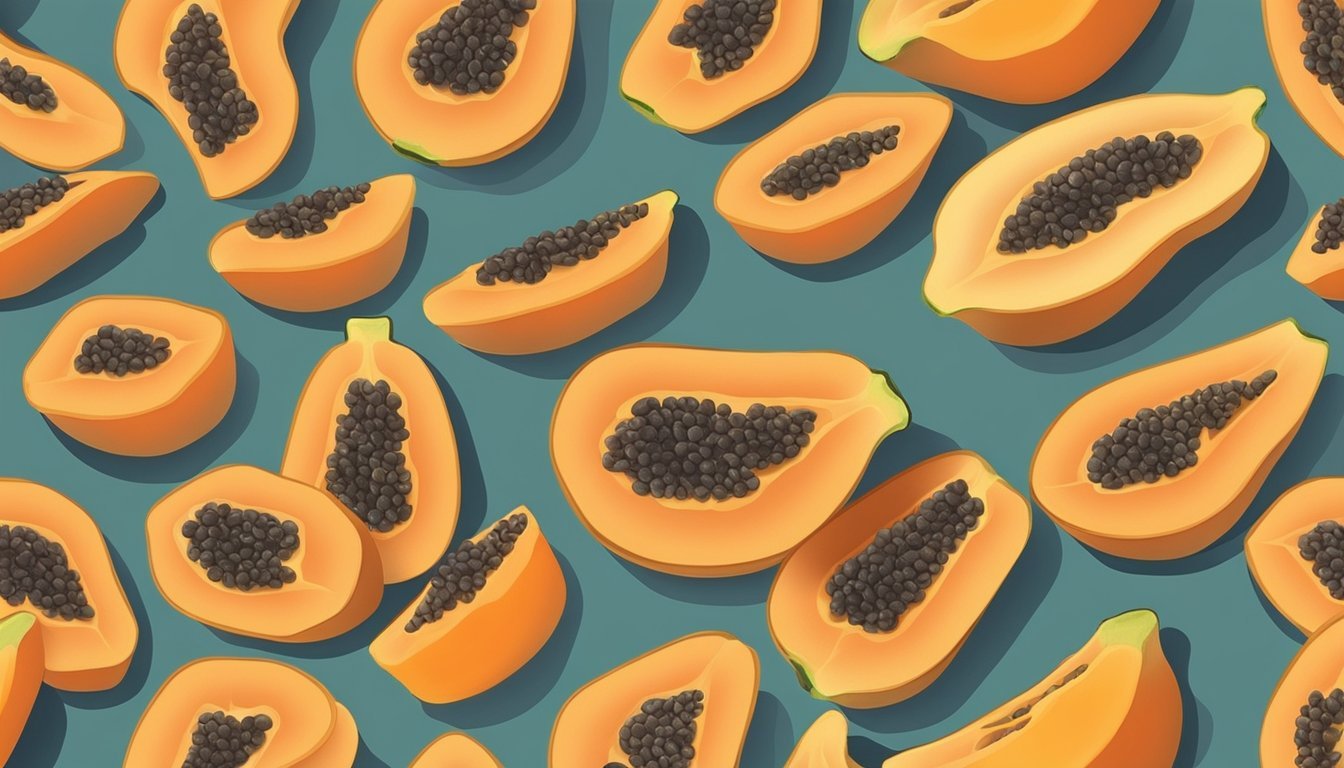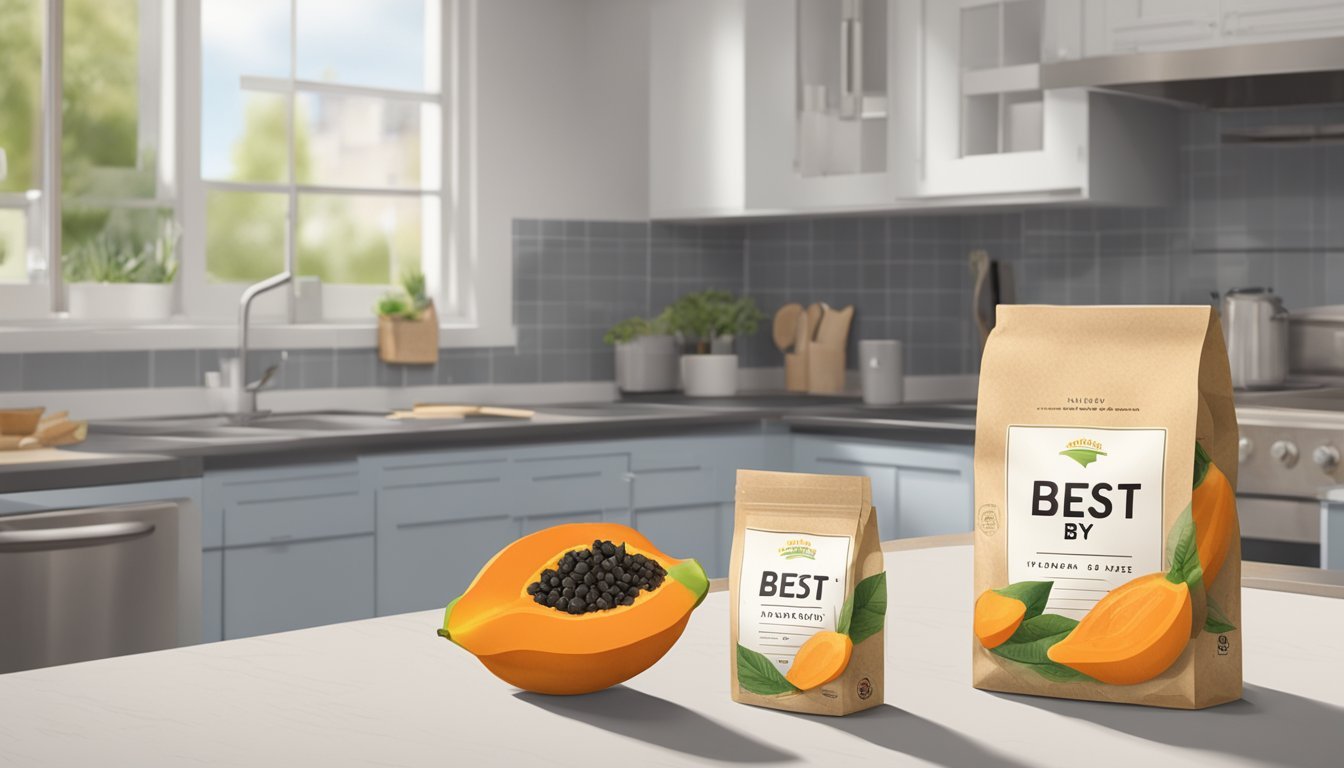How Long Does Dried Papaya Last?
Your Guide to Shelf Life & Storage Tips
Dried papaya is a popular snack, appreciated for its sweet, tropical flavor and nutritional value. When stored properly, the shelf life of dried papaya can vary from several months to a year, allowing consumers to enjoy this dried fruit outside of its natural season. The key factors that impact the longevity of dried papayas include the method of drying, storage conditions, and whether the package has been opened.
To maximize the shelf life of dried papaya, it should be stored in a cool, dry, and dark place. Once the packaging is opened, transferring the papaya to air-tight containers or vacuum-sealed bags can extend its freshness. Refrigeration after opening can also help prolong the fruit's edible state, though it is not always necessary if proper dry storage is available. Through appropriate storage methods, the quality and taste of dried papaya are preserved, ensuring it remains a convenient and healthy option for snacking.
What Is Dried Papaya?
Dried papaya is the dehydrated form of the fresh tropical fruit, the papaya, scientifically referred to as Carica papaya. This process removes most of the moisture from the fruit, concentrating its natural sugars and flavors. As a result, dried papaya is sweeter than its fresh counterpart and takes on a leathery, somewhat chewy texture.
Characteristics of Dried Papaya:
Texture: Chewy and leathery
Flavor: Intensely sweet with concentrated tropical notes
Uses of Dried Papaya:
Snacking: Commonly consumed as a convenient, nutrient-rich snack.
Culinary: Incorporated into baking and cooking recipes for added sweetness and tropical flavor.
Rehydration: Can be rehydrated by soaking in hot water if a softer texture is desired.
Storage:
Ideal Conditions: Should be stored at a cool temperature around 60°F (15°C) to extend its shelf life.
Drying papaya transforms it into a versatile dried fruit, appealing to those seeking a sweet, convenient treat with an essence of the tropics. The added benefits include a longer shelf life and portability, making dried papaya a popular choice for on-the-go snacking and culinary enhancements.
Health Benefits of Dried Papaya
Dried papaya is a nutritious snack that comes with several health benefits. Rich in vitamin C and a good source of fiber, this dehydrated fruit supports various aspects of health.
Fiber: One of the main advantages of consuming dried papaya is its fiber content. Dietary fiber aids in digestion and can help maintain a healthy digestive system. It also contributes to a feeling of fullness, which can be beneficial for those monitoring their appetite.
Antioxidants: Dried papaya is abundant in antioxidants, substances that combat oxidative stress and may reduce the risk of chronic diseases. Antioxidants like vitamin A and vitamin C found in dried papaya are crucial for maintaining healthy skin, good vision, and a robust immune system.
Energy Boost: The natural sugars in dried papaya provide a sweet flavor and an immediate energy boost. Unlike many processed snacks that lead to energy spikes and crashes, the fiber in dried papaya helps modulate the absorption of sugar, offering a more sustained energy source.
Skin and Vision: Regular consumption of dried papaya might contribute to better skin health due to its vitamin A content. Additionally, certain compounds in papaya are known to support eye health and may help in preventing conditions such as macular degeneration.
Moreover, dried papaya may play a role in cardiovascular health by helping to lower cholesterol levels, according to some sources. By incorporating dried papaya into a balanced diet, individuals may enjoy these various health benefits without foregoing taste or convenience.
Preparation and Processing
When preparing papaya for drying, one should start by selecting ripe papayas which exhibit a yellow or orange skin, indicative of optimum sweetness. Unripe green papayas are not suitable as they lack the desired sweetness and may have a more firm texture.
Initial Prep:
Wash: The papaya must be thoroughly washed to remove any dirt or debris on the skin.
Peel: The skin needs to be removed as it can be tough and unpalatable after drying.
Seeds: (how long do seeds last?) Scooping out the seeds is necessary, as they are not typically eaten when dried. However, seeds can be saved for other uses, like tenderizing meat.
Cutting:
Slices: Cut the papaya into consistent slices or chunks to ensure even drying.
Lemon Juice (Optional): Brushing the pieces with lemon juice can prevent browning and add a zesty flavor.
Drying:
Set the Dehydrator: Position the slices on the dehydrator trays without overlap and set the temperature between 55-60°C (131-140°F).
Duration: The drying process usually takes about 8-12 hours, but one should check periodically for a completely dry but pliable texture.
Action Detail Wash Clean thoroughly Peel Remove skin Seed Remove seeds, optional to save for other purposes Cut Slice consistently Optional Brush with lemon juice Dehydrate 55-60°C, 8-12 hours
Proper preparation and careful processing are essential to achieve high-quality dried papaya that is suitable for snacking or incorporating into foods like salads.
Optimal Storage Conditions
Proper storage of dried papaya is crucial for maintaining its quality and extending its shelf life. Factors like temperature, humidity, and exposure to air can all impact the longevity of this treat.
Room Temperature Storage
Dried papaya should be kept in a dry, cool, and dark place such as a pantry. Room temperature is typically optimal, ranging from 68°F to 72°F (20°C to 22°C). For best results, one should store dried papaya in an airtight container to protect it from moisture and pests.
Location: Pantry or cupboard away from heat sources
Container: Airtight to prevent moisture ingress
Refrigeration and Freezing
Although not always necessary, storing dried papaya in a refrigerator or freezer can further prolong its freshness. If one opts for refrigeration, the dried papaya should remain in an airtight container or vacuum-seal packaging to prevent condensation.
Refrigerator:
Temperature: 32°F to 40°F (0°C to 4°C)
Container: Airtight and moisture-resistant
Freezer:
Temperature: 0°F (-18°C) or below
Container: Freezer-safe airtight containers or bags
Note: Use oxygen absorbers for extended freezer storage to reduce oxidation
Long-Term Preservation
For those looking to store dried papaya for an extended period, incorporating oxygen absorbers can be particularly effective. These help to remove oxygen from the environment, which can degrade the quality of the fruit.
Environment: Cool, dark, and dry
Packaging: Airtight with oxygen absorbers for maximum longevity
Shelf Life of Dried Papaya
The shelf life of dried papaya is a crucial factor for consumers seeking to maintain the quality and flavor of this sweet dried fruit. When stored properly, dried papaya can last from 4 months to 1 year. Ideal storage conditions include:
Cool temperature: A cool environment helps to preserve the dried papaya's texture and taste.
Dry conditions: Excess moisture can lead to microbial growth, including mold.
Darkness: Direct sunlight can degrade the quality of the dried fruit by warming it and causing condensation.
Best Practices for Storing Dried Papaya
Sealing: Dried papaya should be kept in an airtight container to prevent exposure to moisture and other contaminants.
Checking: Regular inspection can help detect signs of spoilage, like mold or an off smell, especially in ripe dried papaya that is richer in sugars and more prone to spoilage.
Determining Quality
The longevity of dried papaya can be assessed by its appearance and texture:
Color: Rich, consistent coloring suggests good quality.
Texture: They should be leathery and chewy, not overly hard or sticky.
By adhering to these guidelines, they ensure that consumers enjoy dried papaya at its best. It is, however, important to note that even within the optimal storage time frame, qualities like flavor and texture may diminish gradually, so a prompt consumption is recommended once the package is opened.
How to Tell When Papaya Is Bad
When assessing whether papaya has gone bad, one should consider several indicators. Discoloration is a telltale sign. Fresh papaya typically boasts a vibrant orange or red hue, so any deviation — particularly darkened spots or an overall lackluster appearance — suggests spoilage.
Mold presence is unquestionably a sign of a bad papaya. Even small spots of mold indicate that the entire fruit has likely been compromised, as the mold’s roots can penetrate deep into its flesh. Mold may appear white, green, black, or grey.
To determine the fruit’s condition, one could smell the papaya. A ripe one emits a sweet, tropical scent. If the odor is sour or unpleasant, this could indicate that the papaya is no longer good to eat.
Texture also plays a crucial role in determining the fruit's quality. A spoiled papaya may feel overly soft or mushy to the touch. While a ripe papaya should yield slightly under pressure, it should not be excessively squishy.
Lastly, a taste test, although less advisable, will reveal a spoiled papaya as having a very sour or bitter flavor profile, which is not characteristic of fresh papaya.
Sign of Spoilage What to Look For Discoloration Dull color with darkened spots Mold Any presence of white, green, or black growth Smell Unusual, offputting, or sour aroma Texture Excessive softness or mushiness Taste Sour or bitter flavor (though taste testing is not recommended)
If any of these signs are present, one should err on the side of caution and dispose of the papaya to prevent the risks of consuming spoiled fruit.
Creative Uses for Dried Papaya
Dried papaya can be a versatile ingredient in the kitchen, infusing a tropical flavor into a myriad of dishes. From wholesome snacks to inventive culinary creations, the uses for dried papaya are plentiful.
Culinary Creations
In the realm of culinary endeavors, dried papaya can elevate a simple salad with its sweet and chewy texture. It's also a flavorful addition to desserts; for instance, incorporating dried papaya into muffin or cookie batter can add a unique taste and nutritional value. Chefs may also use finely ground dried papaya as a natural sweetener in pies.
Home-Style Snacks
As for snacks, dried papaya can be enjoyed as is or mixed into trail mixes for an energy-boosting treat. Its natural sugar content can offer a quick pick-me-up with a far lower processed sugar content than many commercial snacks. Homemade granola bars studded with bits of dried papaya provide a balanced blend of flavors and textures.
Recipe Additions
Dried papaya can add a tropical flair to smoothies and milkshakes, offering a concentrated fruit essence without the excess liquid of fresh papaya. When guests are being served breakfast, one can sprinkle diced dried papaya over cereal or yogurt for a delightful contrast. Within recipes, dried papaya's role is not merely confined to snacks and desserts; it can also make unexpected appearances in savory dishes, like a spice rub for meats or a bright component in a grain salad, demonstrating its full potential as a dynamic ingredient.
Tips for Buying and Selecting Papaya
When visiting the market, one should look for papayas that meet certain criteria to ensure they are purchasing a ripe, flavorful fruit. Here are tips to keep in mind:
Ripeness: Papayas are ripe when they are slightly soft to the touch. If the fruit yields gently under pressure, it indicates ripeness. An overly firm papaya may not be ripe, and therefore, not ready to eat immediately.
Color: Opt for papayas with more yellow than green on the skin, as this suggests a higher degree of ripeness. A green papaya is likely not ripe, but it can ripen after purchase if left at room temperature.
Surface: Examine the papaya for any blemishes or black spots. Minor surface imperfections are normal, but large discolored areas or mold spots indicate the fruit may be past its prime.
Size: The size of the papaya does not necessarily relate to its ripeness or taste. One should prioritize the fruit’s firmness and color over size.
Here is a quick checklist:
Attribute What to Look For Ripeness Slightly soft to touch Color More yellow than green, with a uniform skin tone Surface Smooth, free of deep blemishes or mold Size Choose based on personal need, not ripeness or flavor
By following these guidelines, shoppers can feel confident in their ability to select a ripe and delicious papaya from the market.
Food Safety Considerations
When storing dried papaya, one should prioritize food safety to prevent spoilage and contamination. It is imperative to wash hands thoroughly before handling dried papaya to maintain hygiene. If the dried papaya was packaged in a plastic bag or container upon purchase, one must ensure the packaging is not compromised. Any tears or openings could expose the papaya to contaminants.
Once opened, dried papaya should be transferred to an airtight container. This practice not only extends the shelf life by reducing exposure to moisture and air but also prevents the entry of pests or bacteria. If stored in the pantry, ensure it is a cool, dry location. To further extend shelf life, one may also opt to refrigerate the dried papaya.
Following proper food storage guidelines is crucial. Below is a quick reference for handling dried papaya:
Before Storage:
Wash hands with soap and water.
Ensure the dried papaya is dry and free of moisture.
Storage Tips:
Use an airtight container or resealable plastic bags.
Store in a cool, dry, and dark place.
Refrigeration is optional but can extend shelf life.
By adhering to these measures, one can help assure that dried papaya remains safe to consume and its quality is preserved over time.
Methods for Freezing Papaya
Properly freezing papaya can preserve its sweetness and tropical flavor, making it available for use throughout the year. Aiming for optimal freshness requires attention to the preparation, packaging, and freezing process.
Preparing Papaya for Freezing
To prepare papaya for freezing, one should start with ripe papayas that have transitioned from green to a rich yellow or orange color. They should be firm yet slightly soft to the touch, without any bruising. Begin by washing the fruit thoroughly, peel the skin, and remove any seeds. Once cleaned, the papaya can be cut into cubes, slices, or whichever shape preferred for later use.
Freezing Papaya Pieces
After cutting, place the papaya pieces on a cookie sheet in a single layer to ensure they don't stick together. This is known as flash freezing. After they are frozen solid, transfer the pieces into freezer-safe plastic bags or airtight containers. To minimize air contact and avoid freezer burn, one can vacuum-seal the bags. This step is crucial to maintain the papaya's exquisite flavor and texture. Label the containers with the date, and the papaya can be stored in the freezer for up to ten months.
Freezing Papaya Puree
Papaya puree offers a wonderful option for smoothies, milkshakes, or jams. For freezing papaya puree, blend the ripe papaya and strain it to remove any liquid remnants of seeds or skin. The smooth puree should then be poured into an ice cube tray or a freezer-safe plastic bag, depending on the intended future use. Once frozen, the puree cubes can be stored in a plastic bag, which is an excellent way to portion the puree for later use. Ensure all air is squeezed out before sealing to maintain the quality of the puree when frozen.
DIY Dehydrating at Home
Dehydrating ripe papayas at home is a straightforward process that preserves their sweet flavor and extends shelf life. Individuals can use a dehydrator or an oven to achieve this preservation method. The process involves a few simple steps.
When using a dehydrator, one should:
Wash the papayas thoroughly.
Cut the papayas into even slices or chunks to ensure consistent drying.
Arrange the pieces on dehydrator trays, ensuring they do not overlap.
Set the dehydrator's temperature to 130°F (54°C).
The drying time may vary, typically 4 to 12 hours, depending on slice thickness.
For those opting to use an oven:
Preheat the oven to the lowest setting, ideally around 170°F (77°C) if possible.
Prepare the papayas as outlined above.
Place the papaya slices on baking sheets lined with parchment paper.
Leave the oven door slightly ajar to allow moisture to escape.
Regularly check the papayas and turn them periodically, usually taking 6 to 8 hours.
During either method, it's crucial to monitor the papayas to prevent over-drying, which can result in a brittle texture. They should retain a slight chewiness with a concentrated sweet flavor. Once dehydrated, store the papaya in airtight containers in a cool, dark location. Properly dried papayas can be enjoyed long past their fresh counterparts when stored correctly.
Papaya in Traditional and Alternative Medicine
Papaya, a tropical fruit known for its vibrant color and sweet taste, has a storied history in traditional medicine. Cultures around the world have utilized papaya for its medicinal properties, particularly in treating gastrointestinal issues and skin ailments.
Gastrointestinal Relief: People have often turned to papaya for digestive health. Enzymes such as papain, found in the fruit, are known to aid in breaking down proteins and easing digestive discomfort.
Skin Applications: Traditional practices have also applied papaya topically. The fruit is believed to improve wound healing and treat skin infections thanks to its antibacterial properties.
Those who practice alternative medicine have proposed cancer-preventative benefits of papaya. While research is ongoing, certain compounds in papaya, such as lycopene, may have anti-cancerous effects.
Meat Tenderizing: Beyond medical use, papaya's enzyme papain is valuable in culinary settings for its ability to tenderize meat. The enzyme breaks down tough protein fibers, making meats softer and easier to digest.
Papaya Latex: The latex derived from the green papaya fruit contains high levels of papain and has been used in various remedies, pointing to its potential therapeutic properties.
While many of these uses of papaya are supported by anecdotal evidence, scientific research into the full extent of its medicinal benefits is still underway. It should be noted that while traditional and alternative medicine practices point to the potential of papaya, its use should not replace conventional medical treatment without proper consultation.
Conclusions and Recommendations
When it comes to preserving the freshness and extending the shelf life of dried papaya, several best practices should be followed. Dried papaya typically has a shelf life of up to one month when stored in a container at room temperature. However, for a significantly longer preservation, vacuum sealing and freezing is highly recommended.
To ensure optimal longevity, individuals should store dried papaya in a dark, cool, and moisture-free environment. A temperature of less than 72°F (22°C) and a relative humidity of 15% or less are ideal conditions. It is essential to store the dried fruit in an airtight container to prevent exposure to air and moisture, which could compromise quality and flavor.
In the case of freeze-dried papaya, it can last for 25 years or more if properly stored. A clear indication of spoilage is an off smell that is funky, putrid, or sour. Through these methods, they can enjoy this tropical fruit long-term while retaining most of its flavor and nutritional value.
Regarding papaya seeds, for those interested in future planting, store them effectively by first drying them thoroughly after extraction and cleaning. Then, placing them in a dry, clean container, such as a glass jar or an airtight bag, safeguards them until sowing.
By adhering to these storage recommendations, they can maximize the food storage life of both dried papaya and its seeds, while keeping the fruit safe for consumption.












